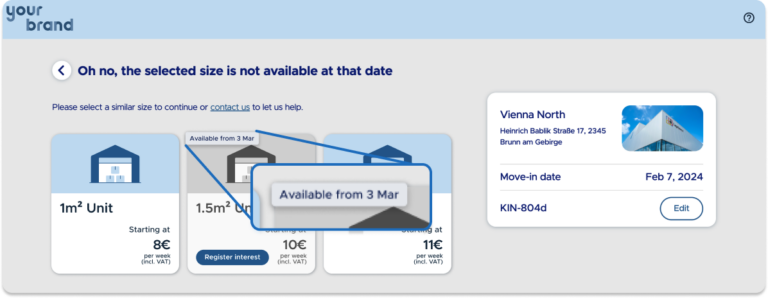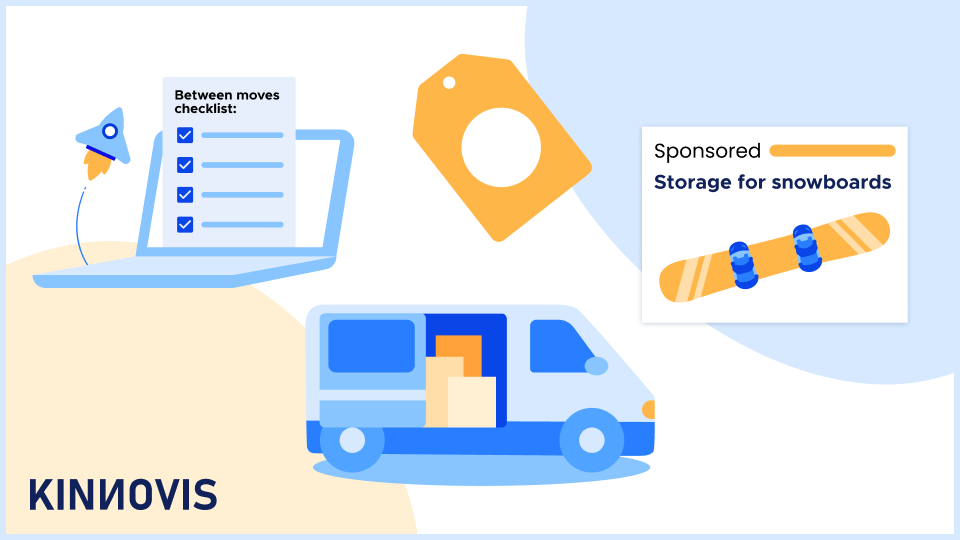
Combatting churn rates in self-storage
What is churn rate?
Churn rate, in the context of a self-storage facility, is the percentage of customers who have stopped renting units within a specific period. This metric is vital for maintaining and improving occupancy levels, planning marketing strategies and identifying potential issues in customer satisfaction levels. In short, the higher your churn rate, the more new customers you need to acquire.
How is churn rate calculated?
An interesting difference exists in how the US and the UK self-storage markets calculate churn rate. In the US, churn rate is calculated using monthly move-outs and measuring them against total occupancy levels at the start of the month. The formula used is:
US Churn Rate (%) = (Number of Customers Moved Out During the Month) / (Number of Occupied Units at the Start of the Month) x 100.
In contrast, the most recent UK industry report looks at the total number of move-outs across the entire year, divided by the occupancy level at the end of that year. The formula used is:
UK Churn Rate (%) = (Number of Customers Moved Out Across the Year) / (Number of Occupied Units at the End of the Year) x 100.
What is the industry average? The UK Self-Storage Association confirmed the average churn rate for 2023 was 98%, a 17% increase from the previous year.
What does this mean, in real terms
A high churn rate doesn’t necessarily mean your self-storage facility is failing, there can be several factors involved. For example, if there’s been a sustained period of sluggish growth, operators may have chosen to increase their rates, rather than improve occupancy levels, to give revenue a boost. This tactic would likely lead to an increase in churn.
There are also a number of external influences which can impact the churn rate of a self-storage facility. Including:
- Seasonality: Changes in demand due to different times of the year. For instance, demand for storage units might increase during the summer when people move houses which could then lead to a spike in move-outs in Autumn and Winter, once the moves have been finalised.
- Covid: The pandemic and its knock-on effects created a significant spike in demand for self-storage. Now some years have passed, this reason for storing is starting to wain.
- Customer’s average lifetime: The typical duration a customer rents a unit will affect churn rates, but it is not something a self-storage business can directly influence. If someone no longer needs your service, then sales and marketing can only go so far. While some self-storage operators may apply tactics which could influence how long their customers store for, such as pricing out short-term storers, the majority welcome all new bookings – regardless of their intended length of storage.
- Maturity of the site: Newer facilities may experience higher churn as they establish their customer base, while more mature sites will have acquired more, long-term customers over the years.
How churn rates can impact your self-storage business
High churn rates, along with fluctuations in churn rates, can significantly impact your self-storage business in several ways. Firstly, they can drive up customer acquisition costs, if churn is high then you’ll need to invest more in marketing and promotions to attract even more new customers to replace those who have left. Secondly, elevated churn rates can affect cash flow, leading to inconsistent revenue streams and financial instability, which can make planning and budgeting more challenging.
Additionally, a high churn rate may be an indicator of more serious underlying problems within your business. Not just within self-storage, if customers are leaving in waves it could be because of a common reason. Perhaps your price rises are too frequent or too steep, there’s growing competition in the market, or specific issues at your facility which customers cannot overlook. Identifying and addressing these problems is crucial for maintaining customer satisfaction and long-term business viability.
Identifying when a customer might leave
While you definitely cannot force a customer to keep storing with you, correctly spotting when they could be about to move-out can at least help you to plan for when they do eventually decide to leave. Some key warning signs could be:
- Changes in how frequently they access their self-storage unit. If a weekly visitor hasn’t accessed their unit in a while, or a long-term storer shows up for the first time in months then it would suggest they’re evaluating their need for your service.
- Updating payment methods. Not always a sign, but if they have a debit or credit card on file that isn’t due to expire for over a year and they switch payment methods, this could be a sign they’re taking a closer look at their finances.
- Customer service interactions. Some are more obvious than others, “what’s the minimum notice I need to provide for move-out?” is a clear sign they’re about to leave, but an overall increase in the number of times they reach out to your customer support can also be an indicator that they’re no longer willing to keep paying for the continued storage of their items at your facility.
Ways to guard against churn rates
We’ve mentioned that there are external variables which generate churn within self-storage that you cannot control. There are also internal variables, however, which you should consider if you want to keep churn rates as low as possible.
- Keep an eye on the competition and define your competitive edge. Self-storage marketplaces like Explorage and Stashbee in the UK can be a great resource for discovering who else is in your vicinity and how your business can stand out from the pack. Getting listed on these platforms can also be a cost-effective lead source, to replace those exiting customers.
- Create marketing strategies for commercial storage customers. People storing for business reasons will typically stay for longer than for individual needs, but it doesn’t mean the two groups can’t overlap. Residential customers may work for or know of businesses in need of space. If you provide any perks, like shared workspaces or courier deliveries, then it could be worth marketing these to your past and present residential customers.
- Offer flexible pricing. A variety of pricing options displayed at the point a customer is ready to book and perhaps even once they’ve moved-in, along with discounts for long-term rentals, will encourage customers to commit to staying longer.
- Utilise technology. A streamlined customer experience will make storing with you not feel like a chore. A straightforward booking system and secure, automated payments are a must.
Ways to minimise the impact of churn
As a final step, it’s important to make sure that, when customers do leave, your business is set up so that the effects are limited and your occupancy levels don’t take a hit.
Ensure vacant units become bookable as quickly as possible.
Streamline your process for preparing and listing empty units to minimise downtime. This involves quickly cleaning and inspecting units, updating your online inventory and making them available for new bookings immediately. The faster you can turn around a unit, the less revenue you lose.
With our Facility Management Software, you can show when a unit is going to become available as soon as a customer has given you a move-out date. You can also set a couple of days buffer, to give your team time to check the unit first.

Turn your outgoing customers into ambassadors.
Encourage exiting customers to share their positive experiences with your facility. Ask them to leave a positive review and offer incentives for referrals. Word-of-mouth recommendations can significantly boost your reputation and work as a low-cost channel for new customers.
A booking portal that converts!
If all else fails, maximising the amount of website traffic that turns into customers is going to replenish your occupancy levels in a flash! A high-converting Booking Portal ensures that visitors to your site are more likely to become paying customers.
Conclusion
Understanding and mitigating churn rates is crucial for maintaining a healthy self-storage business. By closely monitoring the factors that contribute to churn, you can develop effective strategies to both retain customers and keep occupancy levels high. Preparing for inevitable customer departures by streamlining unit turnover processes and leveraging positive customer experiences for future referrals can also minimise the impact of churn.
More articles
Cost-effective ways to increase brand awareness
17 Jul 2024
Marketing self-storage to Gen-Z
12 Jul 2024
Learn effective strategies for marketing self-storage to Gen-Z & Millennials and attract these new storage groups.
How our Booking Portal converts customers
06 Jun 2024
Learn about Conversion Rate Optimisation (CRO) and discover why our Booking Portal is a game changer.



